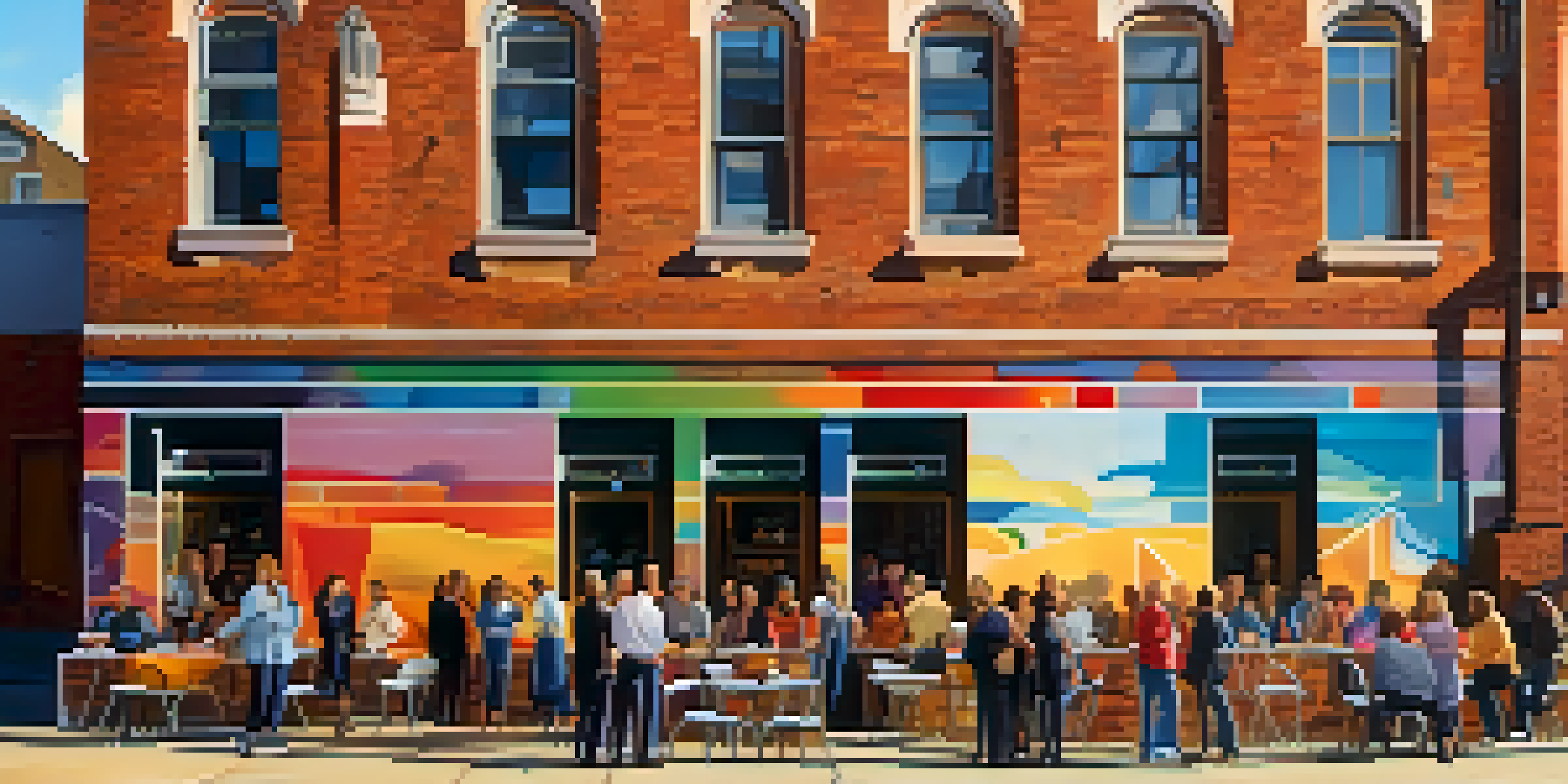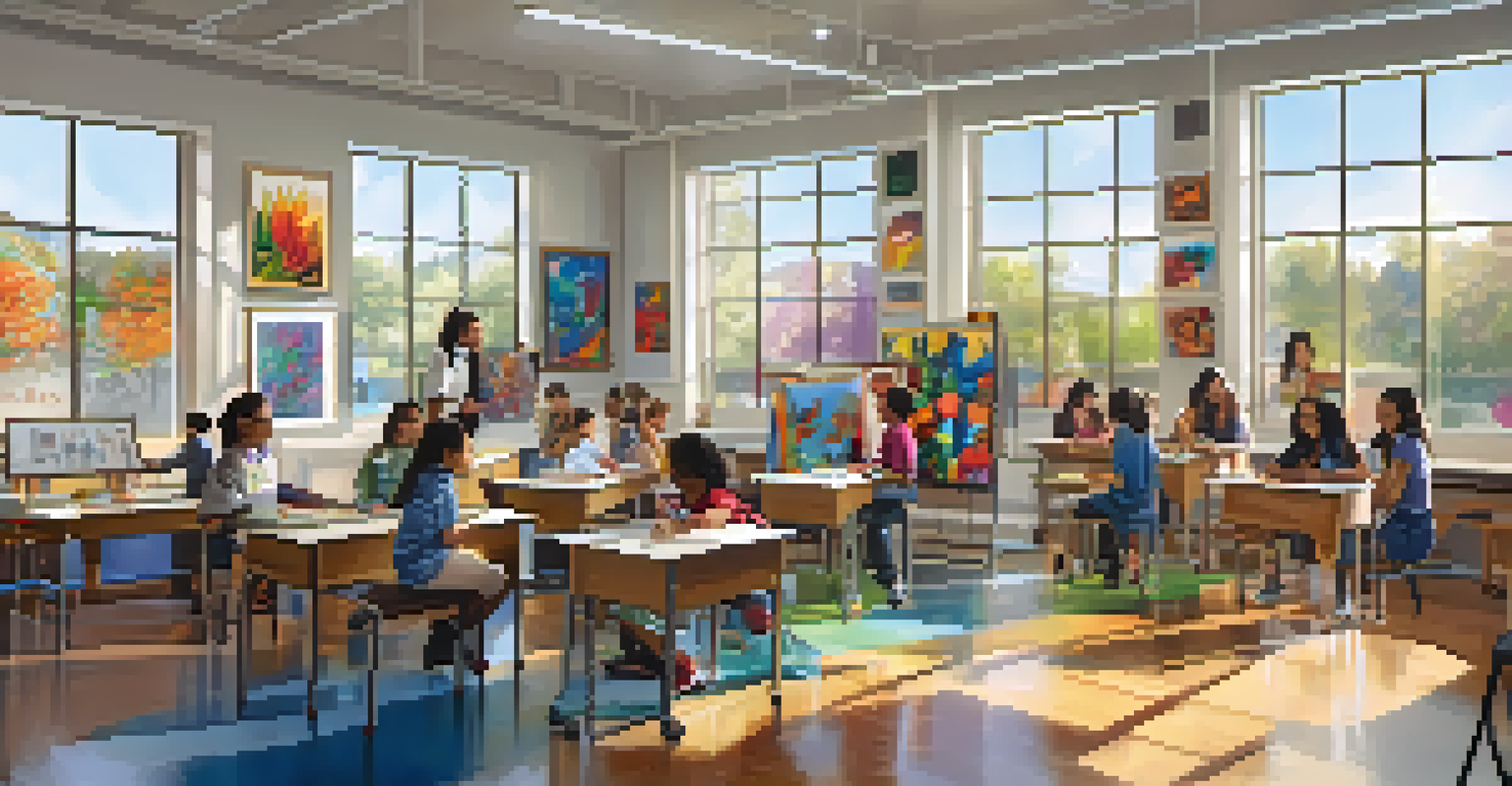The Role of Art in Economic Development and Community Growth

Art as a Catalyst for Economic Growth
Art plays a crucial role in stimulating local economies. By attracting tourists and fostering a cultural vibe, cities with vibrant art scenes often see increased business activity. Think of art festivals or public installations that draw visitors; they create a ripple effect that benefits local shops, restaurants, and hotels.
Art is not freedom from discipline, but disciplined freedom.
Moreover, the creative industries generate jobs and cultivate talent, leading to a more skilled workforce. Artists, designers, and performers contribute to a diverse job market that enhances economic resilience. This variety helps communities adapt to changes, making them less reliant on single industries.
Additionally, investment in the arts can lead to urban renewal. Abandoned buildings transform into galleries or studios, breathing new life into neighborhoods. This not only beautifies the area but also raises property values, encouraging further investment and development.
Community Identity and Pride Through Art
Art is a powerful medium for expressing community identity. Murals, sculptures, and local art events often reflect the history and culture of an area, fostering a sense of belonging among residents. This connection to place can enhance community pride.

When residents feel pride in their community's artistic expression, they are more likely to invest in it emotionally and financially. This could mean attending local art shows, supporting local artists, or even volunteering for community art projects. Such involvement strengthens social ties and promotes a collaborative spirit.
Art Boosts Local Economies
Art stimulates local economies by attracting tourists and fostering business activity.
Furthermore, public art can serve as a unifying force. It often sparks conversations and brings people from diverse backgrounds together. This interaction can lead to greater understanding and cohesion within the community.
The Economic Benefits of Arts Education
Arts education plays a pivotal role in economic development by nurturing creativity and innovation. Schools that prioritize art programs often produce students who think outside the box, a skill highly valued in today's job market. These creative thinkers can lead to breakthroughs in various fields, from technology to healthcare.
Creativity takes courage.
Moreover, engaging with the arts at a young age can improve academic performance across subjects. Studies have shown that students involved in arts education often achieve higher test scores and develop better critical thinking skills. This contributes to a well-rounded workforce that meets the demands of diverse industries.
Investing in arts education also promotes long-term economic growth. By fostering a culture of creativity, communities can attract businesses looking for innovative talent. This not only boosts local economies but also enhances the overall quality of life.
Art's Role in Revitalizing Urban Areas
Urban areas often face challenges like decline and disinvestment, but art can be a powerful tool for revitalization. Creative placemaking initiatives turn neglected spaces into thriving cultural hubs. For instance, transforming an abandoned warehouse into an art gallery can attract foot traffic and encourage new businesses to open nearby.
Additionally, public art installations can beautify urban environments, making them more inviting. When residents and visitors see colorful murals or engaging sculptures, it enhances their experience and encourages them to spend more time—and money—there.
Art Fosters Community Pride
Art enhances community identity and pride, bringing residents together and promoting inclusivity.
Communities that embrace art in their revitalization efforts often see increased safety and social interaction. Well-maintained public spaces foster a sense of ownership and pride, leading to lower crime rates and stronger community bonds.
Art and Tourism: A Symbiotic Relationship
Tourism and art have a symbiotic relationship that can significantly boost local economies. Cultural tourism, where travelers seek out artistic experiences, has become increasingly popular. Cities known for their art scenes, like New Orleans or Santa Fe, attract millions of visitors each year, contributing to their economic vitality.
Art events, such as music festivals and art fairs, draw tourists and create opportunities for local businesses to thrive. Hotels, restaurants, and shops benefit directly from the influx of visitors, often seeing increased sales during major events.
Moreover, art can enhance the overall tourist experience. Unique cultural offerings make destinations memorable, encouraging repeat visits. This ongoing interest in local art can lead to sustained economic growth for communities.
Fostering Inclusivity Through Art
Art has the unique ability to foster inclusivity and bring diverse communities together. By providing platforms for underrepresented voices, art can challenge stereotypes and promote understanding. Community art projects often encourage collaboration between different cultural groups, creating a tapestry of shared experiences.
Moreover, inclusive art initiatives can empower marginalized individuals. By giving them the opportunity to express themselves creatively, these programs can boost confidence and self-worth. This empowerment can translate into economic opportunities, as participants develop skills that are valuable in various job markets.
Investing in Arts Drives Growth
Long-term investments in the arts lead to sustained economic benefits and community resilience.
Creating accessible art spaces is also essential for fostering inclusivity. When everyone has the opportunity to engage with art, it breaks down barriers and promotes a sense of belonging. This inclusivity not only enriches the community but also drives economic growth.
The Long-term Economic Impact of Art Investments
Investing in the arts requires a long-term vision, but the returns can be substantial. Cities that prioritize arts funding often find themselves reaping economic benefits years down the line. For example, the revitalization of a downtown area through art can lead to sustained increases in tourism and business development.
Moreover, arts investments can enhance community resilience. By fostering a vibrant cultural landscape, communities become more attractive to new businesses and talent. This can create a cycle of growth, where the arts continue to stimulate economic activity.

It's important for policymakers to recognize the value of arts investments in their economic strategies. By integrating art into urban planning and community development, they can ensure a more dynamic and prosperous future.
Conclusion: Art's Indispensable Role in Community Growth
In conclusion, the role of art in economic development and community growth cannot be overstated. From job creation to urban revitalization, art serves as a catalyst for positive change. By investing in the arts, communities can foster economic resilience and cultural richness.
Furthermore, art enhances community identity and pride, bringing people together and promoting inclusivity. These social benefits translate into economic advantages, creating a cycle of growth that benefits everyone.
As we continue to explore the intersection of art and economic development, it’s clear that a vibrant arts scene is essential for thriving communities. By embracing the power of creativity, we can build a brighter future for all.